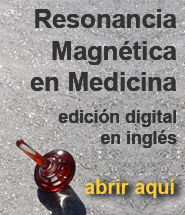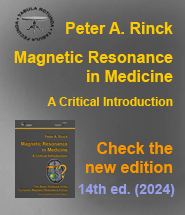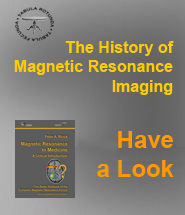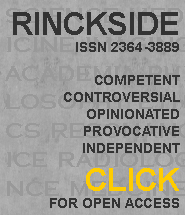Referencias
Capítulo 13
ACR American College of Radiology. ACR Committee on Drugs and Contrast Media. ACR Manual on Contrast Media.Version 7. Reston, VA, USA. 2010. www.acr.org/ SecondaryMainMenuCategories/ quality_safety/ contrast_manual/ FullManual.aspx.
Albert MS, Cates GD, Driehuys B, et al. Biological magnetic resonance imaging using laser polarized 129Xe. Nature 1994; 370: 199-201.
Bayer Healthcare [GEMMA Studies]. FDA approves Bayer's Gadavist (gadobutrol) Injection as the first magnetic resonance contrast agent for evaluation of breast cancer in the United States. 12 June 2014. [Press Release/abstract by Christina Clinton, Bayer].
Bennett CL, Qureshi ZP, Sartor AO, Norris LB, Murday A, Xirasagar S, Thomsen HS. Gadolinium-induced nephrogenic systemic fibrosis: the rise and fall of an iatrogenic disease. Clin Kidney J. 2012; 5: 82–88.
Bloch F, Hansen WW, Packard M. Nuclear induction. Phys Rev 1946; 69: 127.
Chertok B, Moffat BA, David AE, Yu F, Bergemann C, Ross BD, Yang VC. Iron oxide nanoparticles as a drug delivery vehicle for MRI monitored magnetic targeting of brain tumors. Biomaterials. 2008; 29(4): 487–496.
Corot C, Warlin D. Superparamagnetic iron oxide nanoparticles for MRI : contrast media pharmaceutical company R&D perspective. WIREs Nanomed Nanobiotechnol 2013. doi: 10.1002/wnan.1225 [review].
European Medicines Agency (EMEA). Questions and answers on the review of gadolinium-containing contrast agents; 1 July 2010. London: EMEA 2010. Doc. Ref. EMEA/727399/2009 rev. EMEA/H/A-31/1097.
Grobner T. Gadolinium – a specific trigger for the development of nephrogenic fibrosing dermopathy and nephrogenic systemic fibrosis? Nephrol Dial Transplant 2006; 21: 1104–1108. Important Erratum: Nephrol Dial Transplant 2006; 21: 1745.
Hamm B. Contrast materials for cross-sectional imaging of the body. Current Opinion in Radiology 1992; 4 III: 93-104.
Haraldseth O, Rinck PA, Jynge, P, Jones RA. Perfusion imaging of pig hearts and rat brains with gadodiamide inj. (Gd-DTPA-BMA) and sprodiamide inj. (Dy-DTPA-BMA). in: Rinck PA, Muller RN (eds.). New developments in contrast agent research. Proceedings of the 3rd special topic seminar (Hamburg, Germany). European Magnetic Resonance Forum: Minusio, Switzerland 1993. 117-126.
Hingorani DV, Bernstein AS, Pagel MD. A review of responsive MRI contrast agents: 2005–2014. Contrast Media Mol. Imaging 2015; 10: 245–265 [review].
James ML, Gambhir SS. A molecular imaging primer: Modalities, imaging agents, and applications. Physiol Rev 2012; 92: 897–965; doi:10.1152/physrev.00049.2010 [review].
Karlsson JOG, Ignarro LJ, Lundström I, Jynge P, Almén T. Calmangafodipir [Ca4Mn(DPDP)5], mangafodipir (MnDPDP) and MnPLED with special reference to their SOD mimetic and therapeutic properties. Drug Discovery Today 2015; 20,4: 411–421 [review].
Kanda T, Ishii K, Kawaguchi H, Kitajima K, Takenaka D. High signal intensity inthe dentate nucleus and globus pallidus on unenhanced T1-weighted MR images: relationship with increasing cumulative dose of a gadolinium-based contrast material. Radiology 2014; 270: 834–841.
Kanda T, Osawa M, Oba H, et al. High signal intensity in dentate nucleus on unenhanced T1-weighted MR images: association with linear versus macrocyclic gadolinium chelate administration. Radiology 2015, 275: 803–809.
Koretsky AP, Silva AC. Manganese enhanced magnetic resonance imaging (MEMRI). NMR Biomed 2004; 17: 527–531 [review].
Krefting I, FDA. Gadolinium-based contrast agents (GBCAs) and the NSF risk: update. 21 January 2011. US Food and Drug Administration. www.fda.gov
Laurent S, Forge D, Port M, Roch A, Robic C, Vander Elst L, Muller RN. Magnetic iron oxide nanoparticles: synthesis, stabilization, vectorization, physicochemical characterizations, and biological applications. Chem Rev 2008, 108: 2064-2110. Erratum in: Chem Rev 2010, 110: 2574 [review].
Laurent S, Vander Elst L, Copoix F, Muller RN. Stability of MRI paramagnetic contrast media: a proton relaxometric protocol for transmetallation assessment. Invest Radiol 2001; 36: 115-122.
Laurent S, Vander Elst L, Muller RN. Comparative study of the physicochemical properties of six clinical low molecular weight gadolinium contrast agents. Contrast Media Mol Imaging 2006; 1: 128- 137.
Lauterbur PC, Mendonça-Dias MH, Rudin AM. Augmentation of tissue water proton spin-lattice relaxation rates by in vivo addition of paramagnetic ions. Frontiers of Biological Energetics 1978; 1: 752-759.
Leander P. Liver-specific contrast media for MRI and CT. Experimental studies. Acta Radiol Supplementum 1995; 36: S 396.
Marckmann P. An epidemic outbreak of nephrogenic systemic fibrosis in a Danish hospital. Europ J Radiol 2008; 66: 187-190.
Meyer D, Schaefer M, Doucet D. Physico-chemical properties of the macrocyclic chelate Gadolinium-DOTA. in: Rinck PA (ed). Contrast and contrast agents in magnetic resonance imaging. Proceedings of Contrast and Contrast Agents in Magnetic Resonance Imaging – A Special Topic Seminar; Trondheim, Norway; 12-13 September 1988.Trondheim and Mons: The European Workshop on Magnetic Resonance in Medicine (EMRF). 1989. 33-43. [Direct Access].
Middleton H, Black R, Saam B, et al. MR imaging with hyperpolarized 3He gas. Magn Reson Med 1995; 33: 271-275.
Paley MR, Mergo PJ, Torres GM, Ros PR. Characterization of focal hepatic lesions with ferumoxides-enhanced T2-weighted MR imaging. Am J Roentgenol. 2000; 175: 159-163.
Pietsch H, Lengsfeld P, Jost G, et al. Long-term retention of gadolinium in the skin of rodents following the administration of gadolinium-based contrast agents. Eur Radiol 2009; 19: 1417-1424.
Radbruch A, Weberling LD, Kieslich PJ, Eidel O, Burth S, Kickingereder P, Heiland S, Wick W, Schlemmer HP, Bendszus M. Gadolinium retention in the dentate nucleus and globus pallidus is dependent on the class of contrast agent. Radiology 2015; 275: 783-791.
Rinck PA [a], Muller RN. Field strength and dose dependence of contrast enhancement by gadolinium- based MR contrast agents. Eur Radiol 1999; 9: 998-1004. [Direct Access].
Rinck PA [b], Myhr G. Gadolinium chelates: clinical applications. In: Dawson P, Cosgrove DO, Grainger RG (eds). Textbook of contrast media. Oxford: Isis Medical Media 1999. 333-354 [review].
Rinck PA, Petersen SB, Heidelberger E, Acuff V, Reinders J, Bernardo ML, Hedges K, Lauterbur PC. NMR ventilation imaging of the lungs using perfluorinated gases. Magn Reson Med 1984; 1: 237. [Direct Access]. and: Rinck PA, Petersen SB, Lauterbur PC. NMR-Imaging von fluorhaltigen Substanzen. 19-Fluor Ventilations- und Perfusions-darstellungen. Fortschr Röntgenstr 1984; 140: 239-243.
Rinck PA, Smevik O, Nilsen G, Klepp O, Onsrud M, Øksendal A, Børseth A. Oral magnetic particles in MR imaging of the abdomen and pelvis. Radiology 1991; 178: 775-779.
Rummeny EJ, Torres CG, Kurdziel JC, Nilsen G, Op de Beeck B, Lundby B. MnDPDP for MR imaging of the liver. Results of an independent image evaluation of the European phase III studies. Acta Radiol 1997; 38, Pt2: 638-642.
Runge VM. A comparison of two MR hepatobiliary gadolinium chelates: Gd-BOPTA and Gd-EOB-DTPA. J Comput Assist Tomogr 1998; 22: 643-650.
Sieber MA, Lengsfeld P, Frenzel T, Golfier S, Schmitt-Willich H, Siegmund F, Walter J, Weinmann HJ, Pietsch H. Preclinical investigation to compare different gadolinium based contrast agents regarding their propensity to release gadolinium in vivo and to trigger nephrogenic systemic fibrosis-like lesions. Eur Radiol 2008; 18: 2164-2173
Skjold A, Amundsen BH, Wiseth R, Støylen A, Haraldseth O, Larsson HB, Jynge P. Mangenese dipyridoxyl-diphosphate (MnDPDP) as an in vivo viability marker in patients with myocardial infarction. J Magn Reson Imaging 2007; 26: 720-727.
Smith AP, Marino M, Roberts J, Crowder JM, Castle J, Lowery L, Morton C, Hibberd MG, Evans PM. Clearance of gadolinium from the brain with no pathologic effect after repeated administration of Gadodiamide in healthy rats: an analytical and histologic study. Radiology. 2016; [27 Sep 2016; epub ahead of print].
Spinazzi A, Lorusso V, Pirovano G, Taroni P, Kirchin M, Davies A. Multihance clinical pharmacology: biodistribution and MR enhancement of the liver. Acad Radiol 1998 Apr;5 Suppl 1: S86-89; discussion S93-94.
Stinson B, FDA/CDER; Gadobutrol AC. Gadobutrol injection: efficacy, safety, NSF. 21 January 2011. US Food and Drug Administration. www.fda.gov
Tweedle MF. Work in progress toward nonionic macrocyclic gadolinium (III) complexes. in: Rinck PA (ed). Contrast and contrast agents in magnetic resonance imaging. Proceedings of Contrast and Contrast Agents in Magnetic Resonance Imaging – A Special Topic Seminar; Trondheim, Norway; 12-13 September 1988. Trondheim and Mons: The European Workshop on Magnetic Resonance in Medicine (EMRF). 1989. 65-73. [Direct Access].
Vander Elst L, Maton F, Laurent S, et al. A multinuclear MR study of Gd-EOB-DTPA: comprehensive preclinical characterization of an organ specific MRI contrast agent. Magn Reson Med 1997; 38: 604-614.
Vander Elst L, Roch A, Gillis P, Laurent S, Botteman F, Bulte JW, Muller RN. Dy-DTPA derivatives as relaxation agents for very high field MRI: the beneficial effect of slow water exchange on the transverse relaxivities. Magn Reson Med. 2002; 47: 1121-1130.
Weissleder R. Molecular imaging: exploring the next frontier. Radiology 1999; 212: 609-614.
Weissleder R, Papisov M. Pharmaceutical iron oxides for MR imaging. Reviews Magn Reson Med 1992; 4: 1-20.
Weissleder R, Nahrendorf M. Advancing biomedical imaging. PNAS 2015; 112, 47: 14424-14428 [review].












